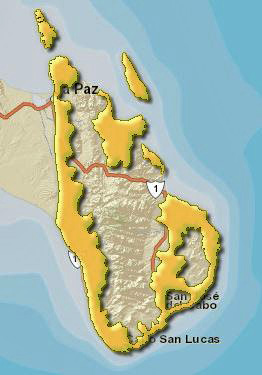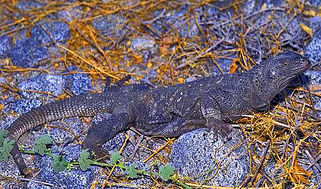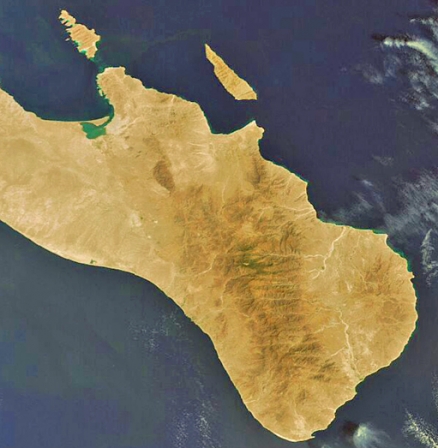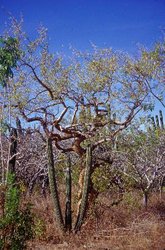San Lucan xeric scrub
The San Lucan xeric scrub is situated at the southern-most part of the Baja Peninsula of Mexico; this diverse landscape of mountains, valleys, and plateaus is covered with a variety of species of xeric vegetation. This neotropical ecoregion is classified within the Deserts and Xeric Scrublands biome. Plants and animals of this region evolved independently before the Baja Peninsula, a previous island during the Miocene, joined the mainland. An arid climate supports a number fauna and species (Biodiversity), about ten percent of which are endemic. This region supports a number of endemic birds and is listed as an Endemic Bird Area (EBA). Established as a Protected Natural Area (PNA), much of the ecoregion remains intact.
Location and general depiction
 San Lucan xeric scrub ecoregion on the southern Baja Peninsula, Mexico. Source: WWF This ecoregion is contained in a larger area known as the Cape Region, and constitutes the southern-most part of the Baja California Peninsula and near shore islands in the Gulf of California. The area originated in the Miocene as an isolated portion of land prior to joining the peninsula in its present position, and thus is considered an biogeographical island of vegetation. The region is composed of a vast, rugged complex of granitic mountains, valleys, canyons, and plateaus. The ecoregion occupies the plateaus between the coast and the lower limits of the dry forests, which begin around 250 meters (m). Precipitation is about 400 millimetres annually.
San Lucan xeric scrub ecoregion on the southern Baja Peninsula, Mexico. Source: WWF This ecoregion is contained in a larger area known as the Cape Region, and constitutes the southern-most part of the Baja California Peninsula and near shore islands in the Gulf of California. The area originated in the Miocene as an isolated portion of land prior to joining the peninsula in its present position, and thus is considered an biogeographical island of vegetation. The region is composed of a vast, rugged complex of granitic mountains, valleys, canyons, and plateaus. The ecoregion occupies the plateaus between the coast and the lower limits of the dry forests, which begin around 250 meters (m). Precipitation is about 400 millimetres annually.
Some elements of dry forest habitat are present in this ecoregion, but xeric elements are dominant and include Chain-link Cholla (Opuntia cholla); Elephant Tree (Bursera microphylla), at the southern limit of its range here and extending north to the Waterman Mountains in the USA; Mauto (Lysiloma divaricata); Organ Pipe Cactus (Stenocereus thuberi), Mala Mujer (Cnidoscolus angustidens), Yucca spp., and Barrel Cacti (Ferocactus spp). Herbaceous elements in the ecoregion include Plantago linearis, Bouteloua hirsuta, and Commelina coelestis.
Biodiversity characteristics
The past and present isolation of Sierra de la Laguna from the rest of the peninsula has played a major role in producing an extraordinary array of unique species. Although the ecoregion has not been studied intensively, it is widely recognized that it harbours 31 of 48 of the reptile species for the Cape Region. Almost a third of the wider [[region]al] recorded species of collembola arthropods and spiders (30 of 138 species, respectively) occur in this ecoregion. In general, over ten percent of animal and plant species found here are endemic. A total of 290 vertebrate species have been recorded in this ecoregion. There are a number of special status taxa that are found in the San Lucan xeric scrub, denoted variously as Near Threatened (NT), Vulnerable (VU), Endangered (EN), or Critically Endangered (CR).
All of the ecoregion is contained within the extensive Baja California Endemic Bird Area. The isolation of this region has also contributed to the scarcity of predators, and to the poor competitive ability of some animals. Rodents and lagomorphs are virtually absent in this region, favoring certain species of animals that would otherwise be subject to competition. This is the case with the Acorn Woodpecker (Melanerpes formicivorus), for example. The Cape Region has also served as a natural refuge for species migrating from neighbouring regions undergoing long-term geological change.
 Spiny Iguana. Source: Bradford D. Hollingsworth/ Encyclopedia of Life Reptiles
Spiny Iguana. Source: Bradford D. Hollingsworth/ Encyclopedia of Life Reptiles
Within the San Lucan xeric scrub ecoregion, reptilian taxa include: the endemicIsland Burrowing Sand Snake (Chilomeniscus punctatissimus); the endemic Isla Cerralvo Snake (Chilomeniscus savagei), restricted solely to Cerralvo Island; the Cape Arboreal Spiny Lizard (Sceloporus licki), a near-endemic restricted to the southern portion of the Baja Peninsula; the near-endemic Spiny Chuckwalla (Sauromalus hispidus NT), found only on Angel de la Guarda Island, Granito, Mejía, Pond, San Lorenzo Norte, San Lorenzo Sur, and other islands in Bahía de los Ángeles, including Cabeza de Caballo, La Ventana, Piojo, Flecha, Mitlàn, and Smith, Gulf of California; the near-endemic San Lucan Leaf-toed Gecko (Phyllodactylus unctus NT), found only on southern Baja Peninsula and some islands within the Gulf of California: Gallo, Partida Sur, Espiritu Santo, Ballena, Gallina and Cerralvo;
Amphibians
There are only a small number of anuran species present in the ecoregion: Red-spotted Toad (Anaxyrus punctatus); and Pacific Chorus Frog (Pseudacris regilla).
Mammals
The Espiritu Santo Island Antelope Squirrel (Ammospermophilus insularis) is endemic to the San Lucan xeric scrub ecoregion and is found only on the island of Espiritu Santo in the Gulf of California. Among threatened mammals occurring in the ecoregion are: the near-endemic Dalquest's Pocket Mouse (Chaetodipus dalquesti VU), known from the Cape Region of the Baja California Peninsula.
Threatened mammals in the ecoregion include: the near-endemic Peninsular Myotis (Peninsular Myotis EN), found only on southern Baja Peninsula; Fish-eating Bat (Myotis vivesi VU), a near-endemic occurring chiefly on the near-shore islands off of the southern Baja Peninsula and mainland Sonora; Mexican Long-tongued Bat (Choeronycteris mexicana NT); and the Lesser Long-nosed Bat (Leptonycteris yerbabuenae VU).
Ecological status
The Mexican state of Baja California Sur, which includes this ecoregion, contains the highest proportion of intact xeric scrub of any Mexican state. Large areas of habitat remain intact, as the topography makes this ecoregion difficult to exploit. In June 1994, the region was established as a Protected Natural Area (PNA) with pine-oak forests and subtropical dry forest as the key areas for protection. The fragile nature of this region requires legal protection over a long period, in order to prevent it from disturbances caused by human overpopulation and exploitation of forest resources for livestock.
Ecological threat profile
Native villagers often kill wild predator species deemed by them as threats to domestic animals. If this practise continues, it could alter the natural processes maintaining biodiversity in the area. Although human disturbance in the Sierra de la Laguna has been minimal, any uncontrolled perturbation to this fragile ecosystem could create an imbalance. This could ultimately cause the disappearance of an extraordinary array of evolutionary phenomena that has produced a unique vegetative assemblage within this vast desert.
Justification of ecoregion delineation
This xeric scrub ecoregion is limited to the southern tip of the Baja Peninsula in Mexico, and is thus isolated from other similar habitats. Delineation for this ecoregion follow INEGI, from which one can group the following vegetation classifications: "sarcocaulous matorral", "crasicaulous matorral", and portions of "agricultural land use". Reference was also made to Rzedowski, and reviews and revisions to the linework were done by expert opinion at several ecoregional priority setting workshops. This ecoregion is coded by the World Wildlife Fund as ecoregion NT1314.
References
- Ted J. Case and Martin L. Cody. 1983. Island Biogeography in the Sea of Cortéz. University of California Press. 508 pages
- C. Michael Hogan. 2009. Elephant Tree: Bursera microphylla, GlobalTwitcher.com, ed. N. Stromberg
- C. Michael Hogan, ed. 2013. Encyclopedia of Life. IUCN:Sauromalus hispidus &Phyllodactylus unctus[1]
- Don Laylander and Jerry Moore (eds). 2006. The Prehistory of Baja California: Advances in the Archaeology of the Forgotten Peninsula. University Press of Florida, Gainesville.
| Disclaimer: This article contains some information that was originally published by the World Wildlife Fund. Topic editors and authors for the Encyclopedia of Earth have edited its content and added new information. The use of information from the World Wildlife Fund should not be construed as support for or endorsement by that organization for any new information added by EoE personnel, or for any editing of the original content. |

